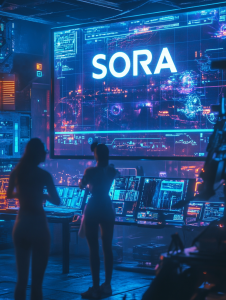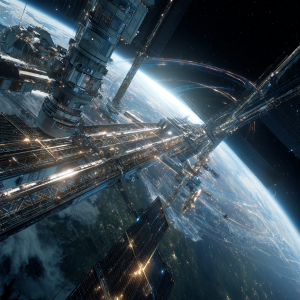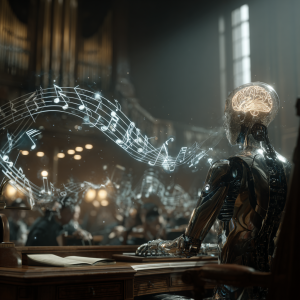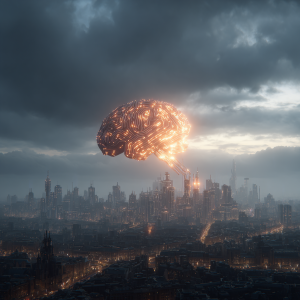Imagine describing a scene like: „a corgi wearing sunglasses rides a skateboard down Venice Beach at sunset.“ Now imagine a video generator—not a person, not a camera—takes that prompt and produces a realistic-looking short film in under a minute. No studio, no editing software, no lighting crew. Just one line of text… and voilà: instant cinema.
Welcome to the world of Sora, OpenAI’s mind-blowing video generation model. If ChatGPT is the writer and DALL·E is the illustrator, Sora is the director, cinematographer, lighting tech, and post-production team rolled into one handy neural network.
In this article, we’re cracking open the magic box: What is Sora? Where did it come from? What’s the tech behind it? And most importantly—what does this mean for the future of film, media, and yes, even the legal world?
So grab your popcorn and a critical thinking cap—we’re rolling.
What is Sora, and Why Is Everyone Talking About It?
Sora is OpenAI’s first publicly announced text-to-video model. It takes a text prompt—anything from “a rainy street in Tokyo” to “a pirate ship battle in outer space”—and turns it into a realistic video clip. Not animation. Not a slideshow. We’re talking about photorealistic, dynamic footage that looks shockingly real.
First unveiled in February 2024, Sora stunned the internet with its demo videos: surreal but believable short clips that felt like someone had plugged imagination directly into a movie studio. And yes, it can do complex camera angles, shadows, reflections, physics, emotions—the works.
Sora is short for the Japanese word “sky”—fitting for a tool that’s trying to remove all creative limits. But it’s not just a cool toy. It represents a paradigm shift in how we create content, tell stories, and express ideas.
Who’s Behind It? (Spoiler: It’s OpenAI)
If the name OpenAI makes you think of ChatGPT, you’re already in the right neighborhood. Sora is another creation from the same lab that gave us ChatGPT, GPT-4, and DALL·E.
OpenAI’s mission is to build artificial general intelligence (AGI) that’s aligned with human values. And while ChatGPT has taken over our keyboards and DALL·E our Instagram feeds, Sora is aiming straight at our screens—and our imagination.
What makes Sora particularly interesting is that it’s not just a side project or experimental prototype. OpenAI is putting serious resources behind it, positioning Sora as a foundational model for future applications—from education and entertainment to training simulations and synthetic media.
So... How Does Sora Actually Work?
We’re about to get just nerdy enough.
Sora is built on transformer-based diffusion models, similar in concept to DALL·E or MidJourney—but designed for video. In simple terms, it takes a prompt, generates a “cloud” of digital noise (random pixels), and then iteratively “denoises” that into a coherent video clip that matches the input description.
But videos are a different beast than images. Sora doesn’t just have to understand what something looks like—it has to understand how it moves, how physics works, how light bounces over time, how people walk, dogs bark, or waves crash against rocks. That’s a major technical challenge.
Early versions of Sora can generate videos up to 1 minute long, at high resolution, with realistic motion and detail. And here’s the wild part: it doesn’t just slap frames together. It simulates temporal consistency—meaning the visuals evolve naturally, like real-life footage.
The model was trained on huge datasets of public and licensed video content. While OpenAI hasn’t disclosed every detail about the data, it’s likely that Sora learned from everything from stock footage to YouTube clips (licensed ones, we hope).
Why Sora Matters (Even If You’re Not a Filmmaker)
You might be thinking, “Cool tech, but I’m not making a sci-fi movie anytime soon.” Here’s why you should care.
Sora is the beginning of a shift toward instant video creation from simple prompts. This changes the game for:
Marketers, who can now create campaign videos without expensive shoots.
Educators, who can simulate scenarios for lessons—from historical reenactments to virtual labs.
Startups, who can pitch ideas with animated prototypes or walkthroughs. Lawyers and investigators, who may eventually recreate accident scenes, crime reconstructions, or courtroom visuals.
Creators and influencers, who suddenly have a Hollywood-level tool in their browsers. We’re not just talking about convenience.
We’re talking about a new creative language, where words become videos. And that opens doors (and ethical wormholes) across every industry.
Sora’s Legal Plot Twist: Copyright, Deepfakes, and Ethical Chaos
Ah yes, our favorite subplot: the legal drama. Let’s not pretend Sora is all sunshine and skateboard-riding corgis. With great generative power comes great regulatory confusion.
Here are a few legal and ethical minefields Sora immediately runs into:
1. Copyright
If Sora generates a scene that looks suspiciously like a Marvel movie or borrows the style of Wes Anderson, who owns that content? OpenAI? The user? The studio that inspired it? As with AI-generated text and images, video adds a whole new layer of complexity.
2. Deepfakes
Sora can technically produce video that mimics real people, places, and voices (though OpenAI has guardrails in place). Still, the potential for abuse—fake news, impersonation, political misinformation—is massive. Expect global legislation to evolve fast around synthetic media.
3. Consent & Data Use
If Sora was trained on real videos (featuring real people), was their consent obtained? Even if it was legally sourced, is it ethically defensible to create synthetic humans based on real ones?
OpenAI has stated that safety is a top priority for Sora. The rollout has been limited and carefully controlled, and features like watermarking and detection tools are already in discussion. But one thing is clear: Sora is walking a legal tightrope. And the stakes? Pretty much the future of video.
Sora vs The Rest: The New Video AI Arena
OpenAI isn’t alone in the text-to-video race. Other major players are sprinting for the same prize, and it’s getting crowded:
Google has announced VideoPoet and Imagen Video, models with similar goals of converting text into video, though none have matched Sora’s output quality yet.
Runway (known for its Gen-2 model) is one of the current leaders in accessible, generative video tools. It’s already being used by creators on platforms like TikTok and YouTube.
Pika and Synthesia are also pushing into the synthetic video space, especially for avatars and explainer content.
But Sora’s clear advantage is the raw quality of its visuals and OpenAI’s cross-platform integration potential. Imagine ChatGPT writing a script, DALL·E generating a storyboard, and Sora turning it into a full cinematic sequence. That’s not a pipeline—that’s a Hollywood-killer.
What Can Sora Do Now? (And What Can’t It Do... Yet?)
Right now, Sora is still in limited access, but based on public demos and early reports, it already showcases some jaw-dropping capabilities. It can generate photorealistic videos from simple text prompts, simulate realistic environments, people, and objects, and maintain temporal coherence over time—meaning scenes stay stable and visually consistent. It even handles complex elements like dynamic camera movement, lighting changes, and natural motion with surprising finesse.
That said, it’s far from flawless. Early outputs sometimes stumble into the uncanny valley with awkward facial expressions, glitchy physics like backward-flowing water or misshapen hands, and the occasional object that vanishes mysteriously mid-scene. These are common growing pains for a model of this scale—and let’s be honest, version one of the iPhone didn’t exactly have Cinematic Mode either.
The Future of Sora: Creativity, Regulation, and a Bit of Sci-Fi
In many ways, Sora is more than a product—it’s a creative philosophy. It challenges the assumption that making high-quality video content requires years of training, huge teams, or enormous budgets.
It also raises difficult questions about reality. If video was once the ultimate proof of truth (“I saw it on video, so it must be real”), what happens when anyone can make hyperrealistic fake footage in minutes?
OpenAI has already flagged Sora as a safety-sensitive technology, and they’re engaging with experts, artists, and regulators to develop ethical frameworks. Expect to see AI labeling standards, authentication protocols, and legal disclaimers baked into future versions.
But even with all the concerns, one thing is certain: Sora is unlocking a new dimension of storytelling. Whether that becomes a utopia of democratized creativity or a dystopia of misinformation—well, that part is still being written.
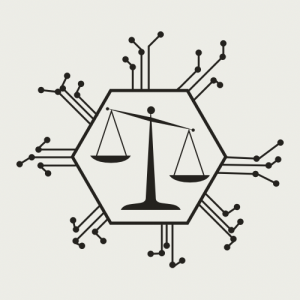
Final Thoughts
Sora isn’t just an impressive piece of tech—it’s a glimpse into the future of content creation. For creatives, it’s exhilarating. For educators and professionals, it’s a breakthrough. And for regulators and ethicists, it’s a challenge.
It’s the kind of tool that makes us ask: If anyone can create a movie in 30 seconds, what does “real” even mean anymore?
Whether you see Sora as a game-changer, a Pandora’s box, or both—it’s here. And it’s just getting started.
Stay curious, stay informed, and let´s keep exploring the fascinating world of AI together.
This post was written with the help of different AI tools.

